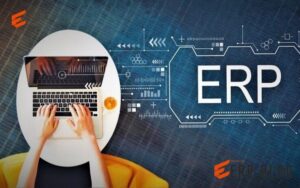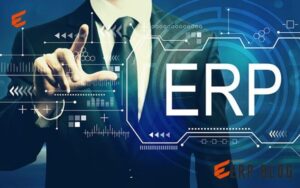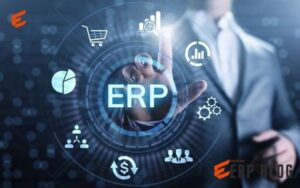ERP – In today’s competitive business landscape, companies are constantly seeking ways to optimize operations and improve efficiency. One of the key strategies many organizations are adopting is implementing an Enterprise Resource Planning (ERP) system. The ERP process is designed to streamline various functions within a business, ensuring that data flows smoothly between departments.
This article will explore what ERP process entails, how it works, and recommend some of the best ERP systems available. Additionally, we will answer frequently asked questions about ERP to provide a complete understanding for businesses considering ERP implementation.
Table of Contents:
What is the ERP Process?
The ERP process refers to the structured approach an organization follows when implementing an Enterprise Resource Planning system. This process involves integrating different business functions, such as finance, human resources, sales, supply chain, and more, into a single cohesive system.
The ERP process aims to centralize data, reduce manual processes, and improve collaboration between departments. With real-time access to key business information, companies can make more informed decisions, enhancing overall productivity and efficiency.
How Does the ERP Process Work?
The ERP process follows a structured approach to ensure smooth integration of various business functions. Each stage of the process plays a crucial role in implementing the system successfully. Here’s a more detailed breakdown of how the ERP process works:
1. Evaluation and Planning
The first step in the ERP process is evaluating the current state of the organization’s operations and identifying areas for improvement. This evaluation involves gathering input from key stakeholders, such as department heads, employees, and decision-makers, to understand the pain points and inefficiencies within the existing processes.
Unlocking the Potential of ERP Xero: A Comprehensive Guide

Once the evaluation is complete, the planning phase begins. During this phase, the company outlines its specific objectives, such as improving inventory management, reducing manual data entry, or enhancing reporting capabilities. A detailed project plan is developed, which includes the scope, timeline, budget, and resources required for the ERP implementation. This stage is critical because it sets the foundation for the entire ERP process and ensures that the organization’s needs are clearly defined.
2. Selection of the ERP System
After planning, the next step is choosing the right ERP software that aligns with the company’s requirements. There are numerous ERP systems available, each with its own set of features, pricing models, and scalability options. Businesses need to evaluate different vendors and select a solution that fits their industry, size, and budget.
Factors to consider during the selection process include:
- Customization options: Can the system be tailored to the company’s specific workflows?
- Scalability: Will the system grow with the business as its needs evolve?
- Integration: Can the ERP software integrate with existing tools or platforms the company already uses?
- Cloud vs. On-premise: Should the ERP be hosted on the cloud for flexibility or on-premise for more control?
Choosing the right ERP system is essential because a poor fit can lead to costly delays, rework, and even failure of the implementation.
3. Data Migration and System Configuration
Once the ERP system is selected, the data migration and system configuration phase begins. During this stage, all relevant data from the company’s existing systems is transferred into the new ERP platform. This data can include customer information, financial records, inventory data, and more.
Before migrating data, it’s important to clean and organize it to avoid transferring outdated or incorrect information. Data migration can be a complex process, depending on the amount of data and the formats involved, so it often requires careful planning and the involvement of IT teams.
Simultaneously, the ERP system is configured to meet the company’s specific needs. This configuration may involve customizing workflows, defining user roles and permissions, and setting up reporting dashboards. The goal is to tailor the ERP system so that it aligns perfectly with the business processes.
The Benefits of ERP Technology for Streamlining Business Operations

4. System Testing and Quality Assurance
Before going live, thorough testing of the ERP system is essential to ensure everything is functioning correctly. Testing helps identify any issues, bugs, or areas where the system doesn’t meet the requirements outlined during the planning phase. Multiple rounds of testing are typically conducted, including:
- Functional testing: Ensures each feature of the ERP system works as expected.
- Integration testing: Verifies that the ERP system integrates smoothly with other software or platforms the business uses.
- User acceptance testing (UAT): Involves employees testing the system in real-world scenarios to ensure it meets their daily operational needs.
Testing allows for adjustments to be made, ensuring a smoother transition once the ERP system is fully implemented.
5. Employee Training and Change Management
One of the most important steps in the ERP process is training employees on how to use the new system. ERP systems often involve significant changes to how employees perform their tasks, so comprehensive training is essential for ensuring adoption. Without proper training, employees may resist the new system or struggle to use it effectively, leading to inefficiencies.
Training sessions should be tailored to different roles within the organization, ensuring that every employee understands how to use the system for their specific tasks. Additionally, organizations may adopt change management strategies to help ease the transition, addressing any resistance to change and ensuring that employees feel supported throughout the process.
6. Go-Live and Post-Implementation Support
After testing and training are complete, the company is ready to go live with the new ERP system. The go-live phase involves switching from the old systems to the ERP platform, which can be done in phases or all at once. A phased approach may be less risky, as it allows the company to gradually transition different departments or functions onto the ERP system.
Even after the ERP system is live, post-implementation support is critical. This support ensures that any issues that arise during the initial stages of usage are promptly addressed. Ongoing system monitoring and updates may also be required to optimize the ERP’s performance and add new features as needed.
Unlocking the Benefits of ERP Reporting for Your Business

7. Continuous Improvement and Optimization
The ERP process doesn’t end after implementation. Businesses should regularly review the system’s performance and gather feedback from users to identify areas for improvement. ERP systems offer analytics and reporting tools that can help organizations measure the impact of the system on productivity, efficiency, and overall business performance.
Over time, companies may need to upgrade their ERP system or add new modules as their operations grow or change. Continuous improvement ensures that the ERP system remains aligned with the company’s goals and can adapt to future challenges.
Best ERP Systems Recommended
When it comes to selecting the right ERP solution, businesses must choose a system that aligns with their specific needs, scalability, and industry requirements. Below are some of the best ERP systems recommended for companies looking to enhance their operations through the ERP process.
1. SAP ERP
SAP ERP is one of the most popular and comprehensive ERP systems in the market, catering to businesses of all sizes. It is widely recognized for its ability to handle complex business processes and is especially suitable for large enterprises. SAP ERP integrates various functions such as finance, supply chain, manufacturing, and human resources into a single system.
SAP provides robust modules for each department, allowing seamless data flow and real-time reporting. It also offers flexibility in deployment, supporting both on-premise and cloud-based environments, making it adaptable to different business needs. For organizations requiring deep industry-specific solutions, SAP ERP is a top choice.
2. Oracle ERP Cloud
Oracle ERP Cloud is another leading ERP solution, particularly known for its strength in financial management and cloud capabilities. It is an ideal option for businesses that are looking to centralize their financial operations while leveraging the benefits of a cloud infrastructure. The ERP process with Oracle enables companies to automate key processes such as budgeting, procurement, and reporting, all while maintaining a high level of security.
Oracle ERP Cloud is highly scalable and can grow with your business, offering tools that streamline workflows and enhance productivity. This makes it a great option for businesses that anticipate future growth and expansion.
3. Microsoft Dynamics 365
Microsoft Dynamics 365 combines ERP and CRM functionalities into a single platform, making it an excellent choice for businesses that want to manage both their operations and customer relationships in one place. This system integrates smoothly with other Microsoft products like Office 365 and Power BI, allowing companies to easily analyze data and gain insights from their operations.
The ERP process with Microsoft Dynamics 365 is streamlined, offering real-time data insights that help businesses make informed decisions. It is user-friendly and customizable, which is beneficial for companies that want a solution tailored to their specific processes.
4. NetSuite ERP
NetSuite ERP is a cloud-based ERP system designed for small and medium-sized businesses, offering a suite of tools that cover everything from financial management to order processing and inventory control. One of the key strengths of NetSuite ERP is its ability to provide a 360-degree view of business operations, helping companies monitor performance in real-time.
The ERP process with NetSuite is straightforward, offering scalability and flexibility that can adapt to changing business environments. It is especially popular among growing businesses that need a cost-effective solution without sacrificing functionality.
5. Infor CloudSuite
Infor CloudSuite offers a comprehensive ERP system tailored to specific industries, such as manufacturing, healthcare, and retail. It is particularly strong in industries that require unique, sector-specific solutions, providing deep functionality that addresses the unique challenges these businesses face.
With Infor CloudSuite, the ERP process focuses on industry-specific modules that help companies streamline their operations, reduce inefficiencies, and increase collaboration across departments. It also offers a cloud-based solution, which allows businesses to operate with greater flexibility and lower infrastructure costs.
FAQs
Conclusion
The ERP process plays a critical role in modernizing business operations by integrating various functions into a unified system. By implementing an ERP solution, businesses can enhance productivity, improve decision-making, and achieve operational efficiency.
Whether it’s a large enterprise or a small business, selecting the right ERP system can have long-term positive impacts on a company’s growth and success.

